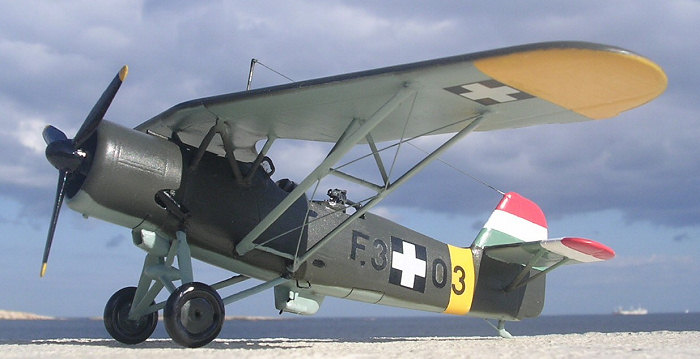
Vac Wings 1/72 He-46C/D
| KIT #: | ? |
| PRICE: | $6.00 |
| DECALS: | No |
| REVIEWER: | Carmel J. Attard |
| NOTES: |

| HISTORY |
The Heinkel He-46 was a short-range reconnaissance aircraft. It first flew in 1931 and went into mass production in 1934 to remain in active duty with the Luftwaffe in 1945 when it formed a Storkampfstaffeln (night harassment squadron) and was expended on the Russian Front. During its long service life the He-46 underwent several engine and structural modifications. The type saw active service during the Spanish Civil War when the type was exported to Spain as the He-46c Pava (Hen Turkey) equipping Grupo 3-G-11 at Avila circa 1937. Bulgaria also received 12-16 of the type but their fate and history remained a mystery. Hungary also received nine He-46eUn. The type was employed practically for reconnaissance missions. A total of 481 He-46s were built by five different manufacturers.
 The He-46 was a mixed construction having fabric-covered
two-spar wooden wing and fuselage of light metal panels forward, fabric aft
fuselage over a welded steel tube structure. The rudder and elevators were
fabric covered and of balanced type. The early type was the He-46c and was
characterised by its large swept wing driven by a two blade fixed pitch wooden
propeller. Its rackly nine-cylinder radial Siemens Apparaten und Maschinen (SAM)
22B engine sent up such a howl and vibration that the pilot could scarcely read
his instruments. The pilot was positioned under the parasol wing centre-section
cut-out while the observer/ gunner/ camera operator was in the aft lower deck
equipped with a single 7.9mm M\G15 machine gun, ring mounted. An aft bay, below
the observer, housed either a Zeiss aerial camera or a maximum of twenty 22 lb
bombs in vertical internal racks.
The He-46 was a mixed construction having fabric-covered
two-spar wooden wing and fuselage of light metal panels forward, fabric aft
fuselage over a welded steel tube structure. The rudder and elevators were
fabric covered and of balanced type. The early type was the He-46c and was
characterised by its large swept wing driven by a two blade fixed pitch wooden
propeller. Its rackly nine-cylinder radial Siemens Apparaten und Maschinen (SAM)
22B engine sent up such a howl and vibration that the pilot could scarcely read
his instruments. The pilot was positioned under the parasol wing centre-section
cut-out while the observer/ gunner/ camera operator was in the aft lower deck
equipped with a single 7.9mm M\G15 machine gun, ring mounted. An aft bay, below
the observer, housed either a Zeiss aerial camera or a maximum of twenty 22 lb
bombs in vertical internal racks.
Even in the 40s, the underpowered He-46 was a ‘Klunker’ in the full sense of the word. At maximum power the vibration was excessive, thanks to its rugged structure that could sustain the ’shakes’; mishandling; and heavy landings. The awkward looking He-46 was easy to fly, reliable to a fault and did have many forgiving characteristics in addition to its leisurely performance. It saw combat service in close support role in the Battle of Brunete in Spain, participated in the 1941 invasion of the Soviet Union in its Hungarian modification He-46e Un, formed part of the Luftflotte 4 during the Polish campaign and its final career as a “night Butcher” in Silesia, near Oppeln when in action against the Russians achieving undeniable success but sustaining heavy losses.
The He-46 had a maximum speed of 161 mph, service ceiling of 19,685 Ft and a range of 615 miles. It had a wing span of 45’ 11 1/4”, a length of 31’ 2” and a height of 11’ 1 ¾ “. It did have a normally docile life and was systemically replaced by the Henchel Hs-126.
| THE KIT |
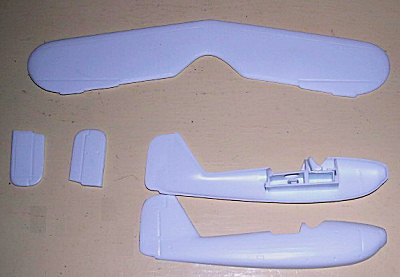 The kit is issued by Vac Wings of Grand Rapids, Michigan. As
the brand itself indicates it is a vac-form kit which comes in a sealed bag
along with a detailed instruction sheet containing information history about the
subject, a 3-view 1/72 scale plans of the He-46c, an exploded view of the he-46
parts, rigging detail and plan view of the two vac form kit parts which come on
two sheets of white plastic. The kit has acceptably accurate basic parts
consisting of tail planes, fuselage halves, main planes, wheels, a propeller,
crew compartment, fuselage halves. The wing struts, fuselage struts and radiator
and aerials were merely printed on the sheet so that it was going to be time
consuming if one tries to cut them from the backing sheet. The alternative was
to use Contrail strips which I did use while the printed kit parts served as
reference for size of width and length of these narrow parts.
The kit is issued by Vac Wings of Grand Rapids, Michigan. As
the brand itself indicates it is a vac-form kit which comes in a sealed bag
along with a detailed instruction sheet containing information history about the
subject, a 3-view 1/72 scale plans of the He-46c, an exploded view of the he-46
parts, rigging detail and plan view of the two vac form kit parts which come on
two sheets of white plastic. The kit has acceptably accurate basic parts
consisting of tail planes, fuselage halves, main planes, wheels, a propeller,
crew compartment, fuselage halves. The wing struts, fuselage struts and radiator
and aerials were merely printed on the sheet so that it was going to be time
consuming if one tries to cut them from the backing sheet. The alternative was
to use Contrail strips which I did use while the printed kit parts served as
reference for size of width and length of these narrow parts.
My initial intention was to produce a representation of one of the 12-16 He-46e that were supposed to be delivered to Bulgaria during WWII, but I could find no further reference to these and I have my doubts if ever these were indeed delivered. The alternative was to build an operational He-46 and sufficient detail was accumulated about the Hungarian Air Force version which in fact carried three varieties of camouflage liveries during its service life.
| CONSTRUCTION |
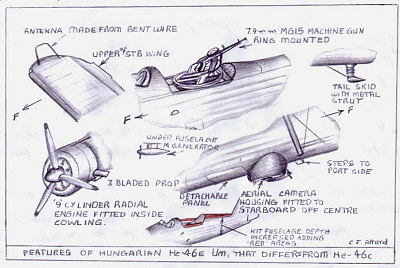 Like
all vac form kit the main parts were first scored with a sharp modelling knife
and snapped off the backing sheet of plastic. The crew compartment parts were
first sized and shaped and assembled so that there is a front pilot office and a
separate observer bay which are separated by a firewall with the crew seats in
place. Detail as seat straps, instrument panel, control stick, rudder pedals
were added from the scrap box which were then shaped to fitting size. Other
pieces as the tail skid, and generator bullet under the fuselage were shaped
from plastic sprue. The fuselage halves were then cut and had plastic strap
pieces added to the joining edges. The interior painted dark grey green and the
pre assembled crew compartment fixed to one half of the fuselage. It was
carefully painted in same colour as the interior. The fuselage halves were then
glued together. Checking the now one piece fuselage I have come across a snag
when I found that the fuselage was not deep enough like the real aircraft. The
depth of the fuselage from the rear of the observer cockpit to the root of the
fin required an additional 3/16” increase to the upper deck. This I added using
three 1/16“strips of plastic built in laminated form. These were faired with
Like
all vac form kit the main parts were first scored with a sharp modelling knife
and snapped off the backing sheet of plastic. The crew compartment parts were
first sized and shaped and assembled so that there is a front pilot office and a
separate observer bay which are separated by a firewall with the crew seats in
place. Detail as seat straps, instrument panel, control stick, rudder pedals
were added from the scrap box which were then shaped to fitting size. Other
pieces as the tail skid, and generator bullet under the fuselage were shaped
from plastic sprue. The fuselage halves were then cut and had plastic strap
pieces added to the joining edges. The interior painted dark grey green and the
pre assembled crew compartment fixed to one half of the fuselage. It was
carefully painted in same colour as the interior. The fuselage halves were then
glued together. Checking the now one piece fuselage I have come across a snag
when I found that the fuselage was not deep enough like the real aircraft. The
depth of the fuselage from the rear of the observer cockpit to the root of the
fin required an additional 3/16” increase to the upper deck. This I added using
three 1/16“strips of plastic built in laminated form. These were faired with
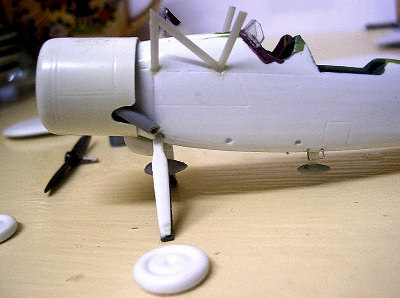 putty and the parts added
are shown red in attached free hand drawings. This shows that the observer side
walls were also raised in height by another 1/8”.
putty and the parts added
are shown red in attached free hand drawings. This shows that the observer side
walls were also raised in height by another 1/8”.
The wing parts were then cut, sanded and joined together and
the same done with the tail planes. Struts were cut and prepared to form the
struts referring to the printed shapes of the ones on plastic as well as to the
scale plans. Once these were made the fuselage struts were first added and
allowed to set. The main wing was then rested and fixed in place checking that
these were correctly aligned with the tail unit and fixed at 90 degrees to each
other. Two long struts were then added to each side of under wing that joined to
the fuselage. These also had cross struts added. Finally, added the tail planes
by simply butt joining them to the rear fuselage. Smaller Vee shaped struts were
scratch built from stretch sprue and also added to the tail planes undersides.
U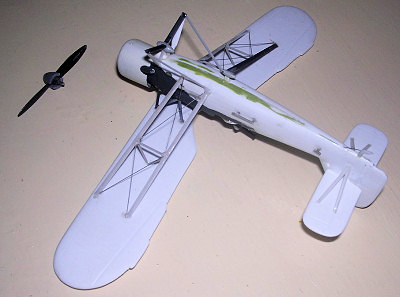 nder wing rigging was added using thin steel wire that was cut to equal lengths
and joined with the under wing struts across using super glue. The Hungarian
He-46e Un had an engine cowling added to the 9 cylinder radial engine. This I
found from the scrap box which was surplus cowling coming from a Antonov An-4
which matched exactly to the size required. As for the 9 cylinder engine I have
discarded the one provided in the kit and fitted one that came from an Airfix
Grief bomber. The three bladed prop which replaced the two bladed one for the
He-46c that came with the kit also came from a Grief engine which was reshaped
and added a spinner to suite. The aerial camera compartment was built up with
putty after a shaped plastic part was glued to the underside of the observer
section. Careful study using photos as reference indicated that it was fixed
offset to the starboard half of the fuselage and adjacent to the motor generator
fitted under the fuselage. Foot steps were added to the port side using steel
wire bent to shape. The vac form wheels were added in the end.
nder wing rigging was added using thin steel wire that was cut to equal lengths
and joined with the under wing struts across using super glue. The Hungarian
He-46e Un had an engine cowling added to the 9 cylinder radial engine. This I
found from the scrap box which was surplus cowling coming from a Antonov An-4
which matched exactly to the size required. As for the 9 cylinder engine I have
discarded the one provided in the kit and fitted one that came from an Airfix
Grief bomber. The three bladed prop which replaced the two bladed one for the
He-46c that came with the kit also came from a Grief engine which was reshaped
and added a spinner to suite. The aerial camera compartment was built up with
putty after a shaped plastic part was glued to the underside of the observer
section. Careful study using photos as reference indicated that it was fixed
offset to the starboard half of the fuselage and adjacent to the motor generator
fitted under the fuselage. Foot steps were added to the port side using steel
wire bent to shape. The vac form wheels were added in the end.
| COLORS & MARKINGS |
There
are various camouflage colours that apply to the aircraft. I elected to do mine
in the olive drab upper and hellblau under surfaces. Having a decal sheet from
the Almarks selection No A15 which is intended for a Hungarian Me-109 but it
also matched 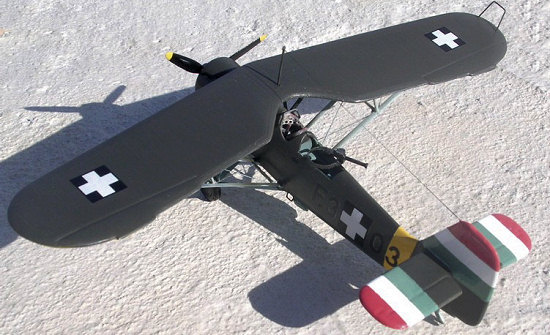 the size of Hungarian, Honved Legiero which was the revised
Hungarian insignia consisting of a black square and a white cross that I needed.
The Hungarian colours were to be applied over the tail unit, fin and rudder. At
times I wonder how an aircraft of this type which was built in substantial
numbers, of a unique parasol design, and which participated in the war was only
produced in vac form. The Hungarian red-white-green tail unit colours were
painted in preference to using the decal strip that comes with the Almarks
sheet. As for the fuselage stripe and wing tips, these were first given a base
coat white and then applied Humbrol yellow. These were masked along with the tri
colour of the tail unit, and the under surfaces was given coats of Model Master
Hellblau RLM65 (2078). After allowing several hours for the paint to set, the
lower surfaces were then masked and all the upper surfaces airbrushed olive
green using Humbrol enamel No 108. At this point I was on pins and needles to
get the paint dry and remove all the masking, but it was worth waiting as in the
end the model appeared in a delightful, colourful scheme. I applied the decals.
The black registration F.303 was a good contrast on the dark olive fuselage. In
the end I added the ringed machine gun arrangement to the aft cockpit. The
windscreen masking was also removed and the kit was given a final coat of
glanzer acrylic ‘Liu’ floor polish liquid to give the kit an overall sheen of
semi matt finish.
the size of Hungarian, Honved Legiero which was the revised
Hungarian insignia consisting of a black square and a white cross that I needed.
The Hungarian colours were to be applied over the tail unit, fin and rudder. At
times I wonder how an aircraft of this type which was built in substantial
numbers, of a unique parasol design, and which participated in the war was only
produced in vac form. The Hungarian red-white-green tail unit colours were
painted in preference to using the decal strip that comes with the Almarks
sheet. As for the fuselage stripe and wing tips, these were first given a base
coat white and then applied Humbrol yellow. These were masked along with the tri
colour of the tail unit, and the under surfaces was given coats of Model Master
Hellblau RLM65 (2078). After allowing several hours for the paint to set, the
lower surfaces were then masked and all the upper surfaces airbrushed olive
green using Humbrol enamel No 108. At this point I was on pins and needles to
get the paint dry and remove all the masking, but it was worth waiting as in the
end the model appeared in a delightful, colourful scheme. I applied the decals.
The black registration F.303 was a good contrast on the dark olive fuselage. In
the end I added the ringed machine gun arrangement to the aft cockpit. The
windscreen masking was also removed and the kit was given a final coat of
glanzer acrylic ‘Liu’ floor polish liquid to give the kit an overall sheen of
semi matt finish.
| CONCLUSIONS |
As one can see the Hungarian He-46e UN was a small but colourful aircraft which will stand out in any kit collection. It may be a good idea if the Hs-126 is built and accompanies the Heinkel. These rare vac kits are not easy to find these days. Thanks to Bill Arnold of Erie, Penn from whom I was able to acquire the Vac Wings He-46 kit.
| REFERENCES |
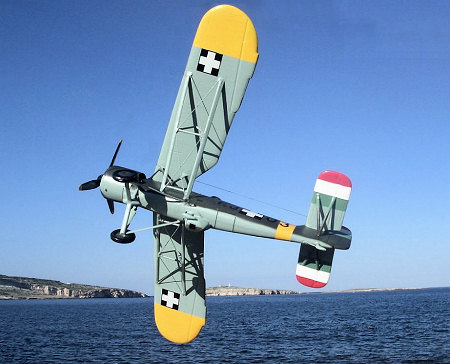 Kit instructions
Kit instructions
Photos from internet Hungarian web site.
December 2007
If you would like your product reviewed fairly and fairly quickly, please contact the editor or see other details in the Note to Contributors.